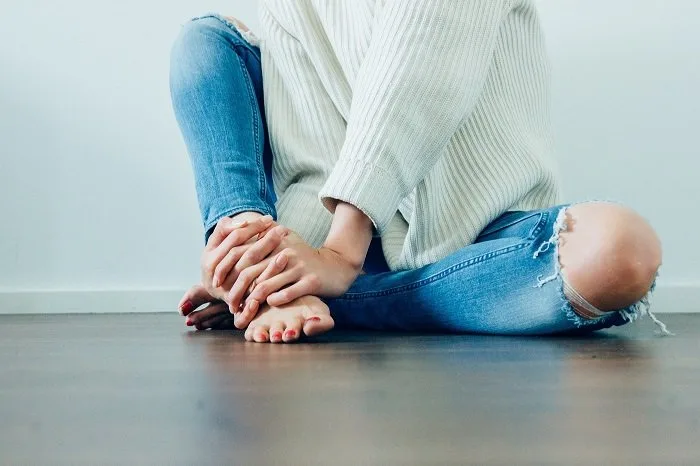Whether to sit or stand at work is currently a very hot topic. Many people who sit at work are switching to “standing desks,” which began when the wellness community started pushing the idea that “sitting is the new smoking.” This movement came from controversial research that showed that people who are sitting all day at work were in poorer health than those who did not.
However, ask anyone who works on their feet how their legs feel at the end of the day—such as teachers, nurses, cashiers and pharmacists, just to name a few—and most will tell you that their legs are tired and swollen and feel heavy. All of these symptoms are the result of high pressure in the veins.
As a vascular specialist, I know that standing all day is not good for your veins. When we stand, our veins are under pressure, which causes aching and swelling and also results in chronic vein problems like varicose veins. Sitting is not so great either, because when we sit, we are not doing anything to get our blood moving.
Below, I explain why standing or sitting all day at work results in venous problems and then offer my top tips as a vascular surgeon for feeling better after a long day.

Why Standing or Sitting All Day Is Bad for You
When you stand, you create high pressure in your veins. To be more precise, this pressure is hydrostatic pressure, which is simply the pressure that results from the weight of a column of fluid because of the force of gravity. When we are standing, that pressure is significant because of the distance from our feet to our heart.
Our veins do have valves to keep the blood flowing in the correct direction while we’re standing, but these only come into play when we are moving or walking. This is called the “calf muscle pump.” When we walk or move, our calf muscle squeezes the vein, the valves in the vein close and blood is forced toward the heart. If the valves don’t work (chronic venous disease) or we are not moving, venous blood can go in the wrong direction or just sit stagnant.
With sitting (as opposed to standing), the hydrostatic pressure in the veins is lower because the distance from your feet to your heart is smaller. However, when we sit, we don’t move our leg muscles at all, so our vein valves are wide open and the venous blood is stagnant and under pressure. At least when we stand, we are shifting a little and to a minor degree using the calf muscle pump. From a venous health standpoint, sitting and standing are equivalent.
As a vascular specialist, I see lots of patients with chronic venous disease, lymphedema and leg swelling. Most of these patients have jobs that require prolonged sitting and standing. The medical issues that I see are the same whether people stand all day at work or sit all day at work.
What to Do if You Stand or Sit All Day at Work
1. Move as much as you can.
Try to stay active as much as you can at work. Walking allows you to take advantage of the calf muscle pump, which gets the blood in your veins flowing again and lowers the pressure in the veins. If you sit at work, try to get up and walk at least every hour. Something as simple as going to the water fountain is helpful. It will also keep you hydrated and then you have an excuse for more “bathroom breaks.” If you stand all day at work, simply doing calf raises for 30 seconds will get the venous blood flowing and lower the pressure in the veins. Also, get a quick stretch in now and then. 
2. If you have a standing desk, consider upgrading to a treadmill desk.
Standing desks are the new craze as those in the wellness community are advertising the dangers of sitting. Granted, sitting and being inactive all day is not healthy, but standing all day will also have a big impact on your venous health. The treadmill desk is the perfect solution. By walking at a slow pace, which is not tiring and does not interfere with your work, you are activating your calf muscle pump and keeping your venous blood flowing. You can alternate this with sitting. If a treadmill desk isn’t an option, you can sit on an exercise ball for your chair, which gets you moving a bit and also works your core.
3. Wear compression stockings.
Whether you sit or stand all day at work, your veins are under high pressure. Compression socks compress your veins to keep the venous blood from being stagnant and under pressure. They are manufactured so that there is a pressure gradient that results in the movement of the blood in your veins back towards your heart.
4. When you get home from work, elevate your legs for 15-20 minutes on a leg elevation pillow.
Proper positioning is important because leg elevation must be done correctly to increase venous blood flow, reduce venous pressure and reduce swelling. The Lounge Doctor Leg Rest is the only patented leg elevation device on the market that elevates the legs correctly. If you are lucky enough to have a couch at work, consider keeping a leg rest at work to use during your break. You can also keep one at home and elevate your legs for 15-20 minutes before going to bed.
5. Take a walk at the end of the day.
Because of the effectiveness of the calf muscle pump, walking increases venous blood flow and lowers venous pressure. It also helps you maintain a healthy weight, which lowers your risk of vein problems.
6. Invest in good shoes.
If you stand all day at work, invest in a good pair of shoes that are comfortable, well-cushioned and have good support. Your legs and back will thank you.
7. Try to maintain good posture.
Whether sitting or standing, try to maintain good posture. Keep your core tight (abdomen sucked in), your back straight and your shoulders held back. This will help fend off the pain and stiffness that comes from bad posture.
Hopefully, these seven tips will help you maintain a healthy lifestyle despite having to stand or sit all day at work. Get creative and come up with your own tricks for creating a healthy environment at work. Set an example for others and become an ambassador for wellness at your workplace.



![women [longevity live]](https://longevitylive.com/wp-content/uploads/2020/01/photo-of-women-walking-down-the-street-1116984-100x100.jpg)










